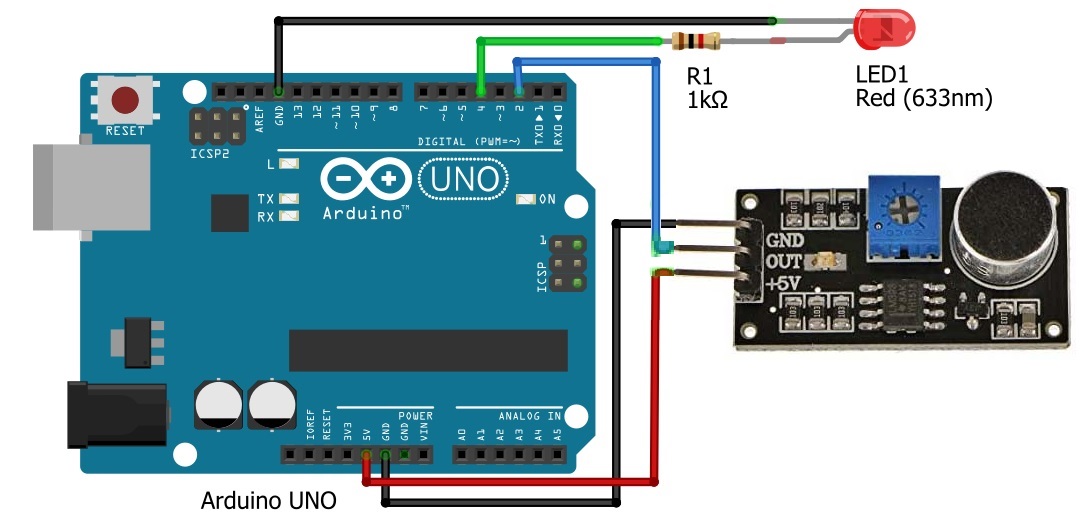Features:
- Operating Voltage: DC 3.3V - 6V
- IC Chip: LM393 Dual Comparator
- Output Type: Digital signal (LOW when sound detected)
- Adjustable Sensitivity: Onboard potentiometer for fine-tuning threshold
- Signal Indicator: Onboard LED lights up when sound exceeds setpoint
- Mounting: Bolt hole for easy attachment to cases or panels
- Single Channel Output: Processes input from a single microphone
Principle of Operation:
- Microphone: Detects ambient sound waves and converts them to a weak analog voltage signal.
- Amplification: LM393 amplifies the weak signal for comparison.
- Threshold Setting: Adjustable potentiometer sets the voltage threshold level.
- Comparison: The LM393 compares the signal from the microphone to the threshold value.
- Digital Output: If the sound exceeds the threshold, output goes LOW (0V), triggering the LED.
Pinout:

| Pin |
Description |
| GND |
Connect to microcontroller GND |
| +5V |
Power supply input (3.3V to 6V) |
| OUT |
Digital output (LOW when sound exceeds threshold) |
Applications:
- Clap-activated switches
- Voice-controlled systems
- Animal sound detection
- Noise monitoring or alarms
- Interactive sound-reactive installations
Circuit Diagram:
Example wiring to an Arduino UNO:
- OUT → Pin 2 (Digital Input)
- VCC → 5V
- GND → GND
- LED → Pin 4 (via 220Ω resistor)

Arduino Code Example:
const int ledPin = 4;
const int microphonePin = 2;
int state = LOW;
void setup() {
pinMode(ledPin, OUTPUT);
pinMode(microphonePin, INPUT);
Serial.begin(9600); // Start serial communication
}
void loop() {
state = digitalRead(microphonePin);
Serial.print("Microphone state: ");
Serial.println(state);
if (state == HIGH) {
digitalWrite(ledPin, HIGH);
Serial.println("LED ON");
delay(1000);
} else {
digitalWrite(ledPin, LOW);
Serial.println("LED OFF");
}
delay(100); // Avoid flooding the serial monitor
}
Technical Specifications:
| Parameter |
Value |
| Comparator IC |
LM393 |
| Operating Voltage |
+3.3V to +6V |
| Mounting Hole Size |
3mm |
| Dimensions |
3.1cm x 1.6cm x 0.8cm |
| Output Type |
Digital LOW when triggered |
| Color |
Black |
Resources:
Comparison with KY-037 Module:
| Feature |
LM393 Module |
KY-037 Module |
| Working Voltage |
3.3V - 6V |
4V - 6V |
| Comparator Chip |
LM393 |
LM393 |
| Output |
Digital only |
Digital + Analog |
| Signal Indicator |
Yes (LED) |
Yes (LED) |
| Size |
32mm x 17mm x 15mm |
32mm x 14mm x 18mm |
Features:
- Operating Voltage: DC 3.3V - 6V
- IC Chip: LM393 Dual Comparator
- Output Type: Digital signal (LOW when sound detected)
- Adjustable Sensitivity: Onboard potentiometer for fine-tuning threshold
- Signal Indicator: Onboard LED lights up when sound exceeds setpoint
- Mounting: Bolt hole for easy attachment to cases or panels
- Single Channel Output: Processes input from a single microphone
Principle of Operation:
- Microphone: Detects ambient sound waves and converts them to a weak analog voltage signal.
- Amplification: LM393 amplifies the weak signal for comparison.
- Threshold Setting: Adjustable potentiometer sets the voltage threshold level.
- Comparison: The LM393 compares the signal from the microphone to the threshold value.
- Digital Output: If the sound exceeds the threshold, output goes LOW (0V), triggering the LED.
Pinout:

| Pin |
Description |
| GND |
Connect to microcontroller GND |
| +5V |
Power supply input (3.3V to 6V) |
| OUT |
Digital output (LOW when sound exceeds threshold) |
Applications:
- Clap-activated switches
- Voice-controlled systems
- Animal sound detection
- Noise monitoring or alarms
- Interactive sound-reactive installations
Circuit Diagram:
Example wiring to an Arduino UNO:
- OUT → Pin 2 (Digital Input)
- VCC → 5V
- GND → GND
- LED → Pin 4 (via 220Ω resistor)

Arduino Code Example:
const int ledPin = 4;
const int microphonePin = 2;
int state = LOW;
void setup() {
pinMode(ledPin, OUTPUT);
pinMode(microphonePin, INPUT);
Serial.begin(9600); // Start serial communication
}
void loop() {
state = digitalRead(microphonePin);
Serial.print("Microphone state: ");
Serial.println(state);
if (state == HIGH) {
digitalWrite(ledPin, HIGH);
Serial.println("LED ON");
delay(1000);
} else {
digitalWrite(ledPin, LOW);
Serial.println("LED OFF");
}
delay(100); // Avoid flooding the serial monitor
}
Technical Specifications:
| Parameter |
Value |
| Comparator IC |
LM393 |
| Operating Voltage |
+3.3V to +6V |
| Mounting Hole Size |
3mm |
| Dimensions |
3.1cm x 1.6cm x 0.8cm |
| Output Type |
Digital LOW when triggered |
| Color |
Black |
Resources:
Comparison with KY-037 Module:
| Feature |
LM393 Module |
KY-037 Module |
| Working Voltage |
3.3V - 6V |
4V - 6V |
| Comparator Chip |
LM393 |
LM393 |
| Output |
Digital only |
Digital + Analog |
| Signal Indicator |
Yes (LED) |
Yes (LED) |
| Size |
32mm x 17mm x 15mm |
32mm x 14mm x 18mm |


